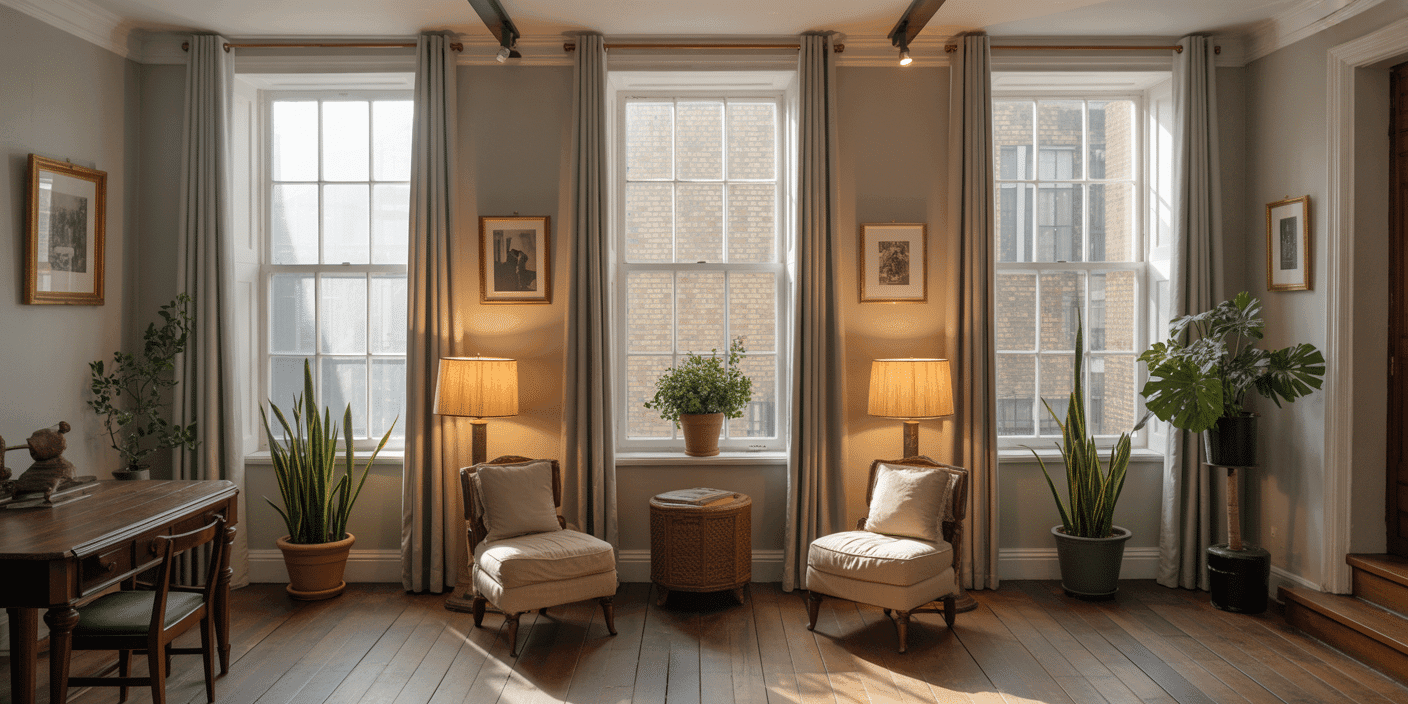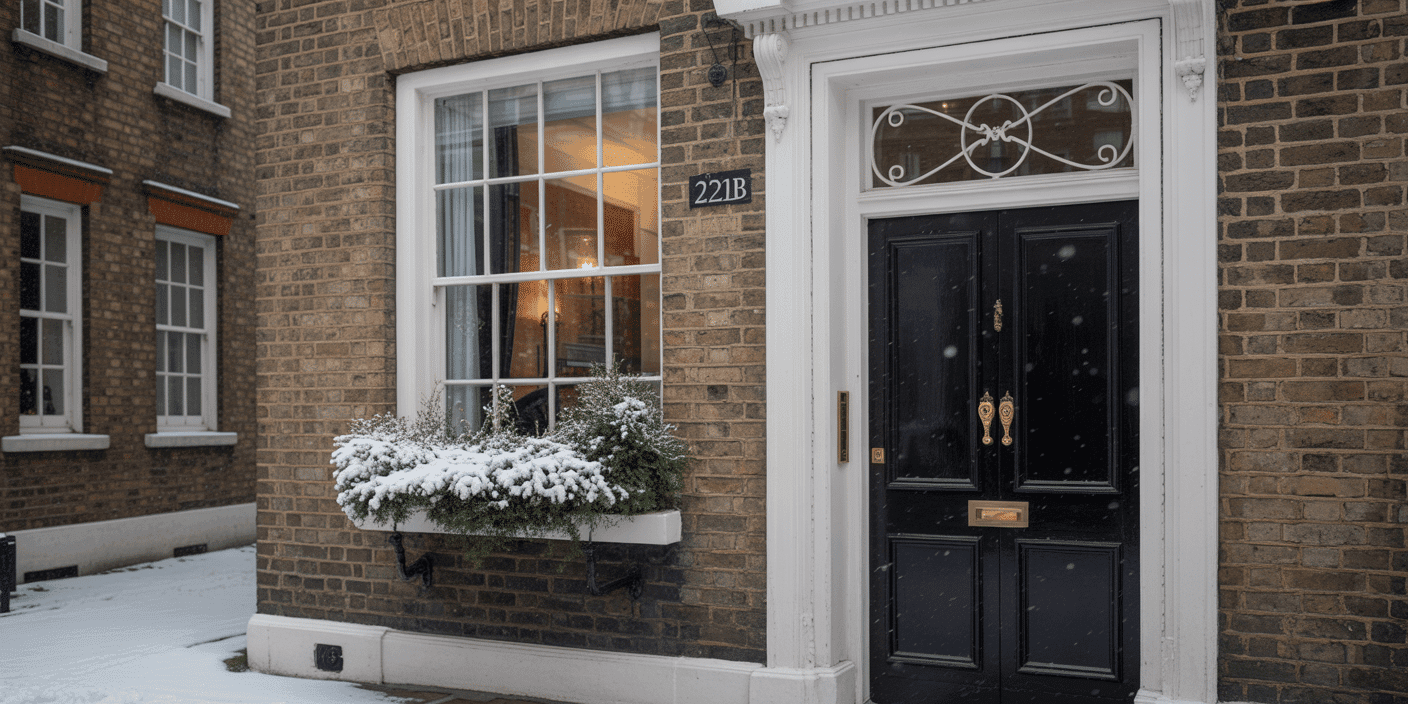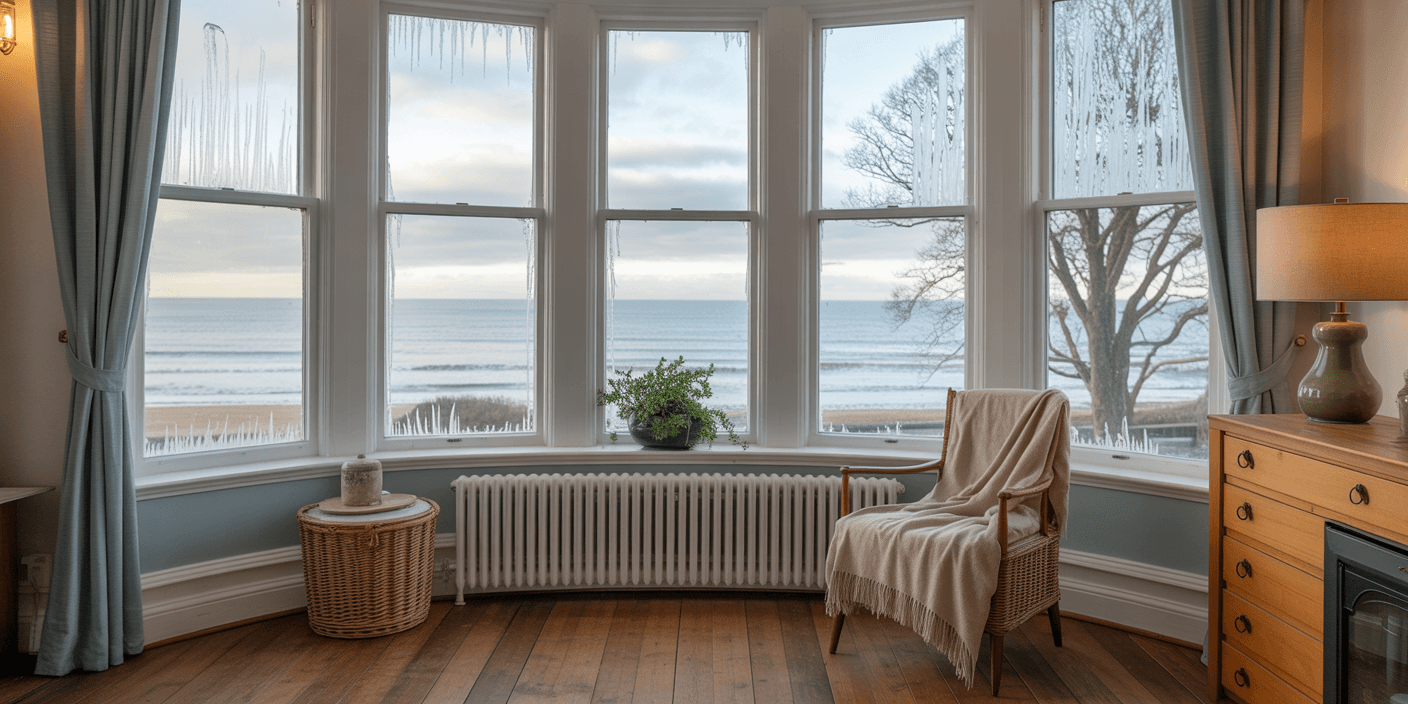The North Remembers — And So Should Your Windows
Northern Britain is known for its architectural beauty — from stone terraces in Durham to Georgian townhouses in York and Victorian villas across Cumbria. These homes are testament to an era of craftsmanship rarely matched today. Yet while the masonry and design have endured, the same cannot be said for their thermal performance.
Beneath the elegance of original timber frames and slender glazing bars lies a persistent issue: heat loss. Cold air infiltrates through ageing seals, worn sashes, and outdated single-pane glass. Every winter, thousands of pounds in heating are lost to inefficiency, while condensation and draughts compromise comfort and air quality.
Many homeowners, reluctant to disturb the historic character of their properties, have resigned themselves to the chill — layering jumpers indoors, overworking boilers, and tolerating windows that whistle in the wind.
This perception — that one must choose between authenticity and insulation — is no longer accurate.
With the advent of heritage-sensitive glazing technologies, it is now possible to retain period aesthetics while achieving modern thermal standards. These advancements honour the architectural integrity of sash windows while significantly improving energy efficiency, acoustic insulation, and comfort — particularly vital in the harsher climates of the North.
Professionals with expertise in this specialised field have transformed sash window restoration into a discipline of precision — aligning conservation principles with 21st-century performance.
This guide explores the most effective glazing strategies for period properties in cold northern regions — from discreet double glazing to conservation-approved upgrades. Whether you are safeguarding a listed townhouse or future-proofing a rural cottage, this information may well determine whether your home remains merely beautiful — or becomes truly habitable.
It’s Not the Window — It’s the Wrong Glass
Let’s clear up a common misconception.
When a room is cold, most homeowners blame the window itself — the frame, the sash, the draughty joinery. And while timber can degrade over time, it’s not the true culprit of your discomfort. Nine times out of ten, the real problem is far simpler, and far colder: the glass.
Single-pane glazing, common in older sash windows, offers virtually no insulation. It’s a silent conduit for heat escape — bleeding warmth from your living space and inviting condensation, cold spots, and rising energy bills.
But it’s not just age that causes this. Even modern glass can underperform if it’s specified poorly or installed without regard for climate and context.
Most double glazing solutions are designed for general use, not for traditional sash windows in cold, high-exposure environments. Thick, chunky units distort the appearance of heritage frames, often fail planning permission in conservation areas, and can even throw the balance and weight system off entirely. Worse still, poorly installed glazing — no matter how new — can create thermal bridges, resulting in mould, rot, and structural damage over time.
So, if your windows are underperforming, don’t blame the timber. The frame may be part of the story, but the real plot twist is in the pane.
The good news? There are now specialist glazing systems engineered precisely for traditional sash windows — ones that fit the slim profiles, meet modern regulations, and stand up to the punishing climate of the North.
Knowing which glazing solution to use isn’t just a technical choice — it’s a decision that affects your comfort, compliance, and long-term energy savings.
In the next sections, we’ll explore those options — from discreet slimline double glazing to triple-glazed units for extreme weather, and secondary glazing for listed buildings where replacements aren’t allowed.
Each has its place. But not all are created equal. And only the right one will do for your property.
Slimline Double Glazing – The Heritage Hero

If you live in a period home in the North, you’ve likely wrestled with a cruel irony: your windows were designed to impress, not to insulate.
But what if you didn’t have to choose between comfort and conservation?
Enter slimline double glazing — the precision-engineered answer to cold climate living within traditional sash windows. Not a compromise. Not a clumsy retrofit. But a system specifically designed to preserve heritage while delivering warmth.
What is it?
Slimline double glazing uses two panes of glass, typically just 11mm to 14mm thick in total, with a narrow cavity filled with inert gas (often argon or krypton) and a Low-E coating that reflects heat back into the room.
It fits directly into existing sash window profiles or bespoke timber frames — maintaining the elegant sightlines, original glazing bar patterns, and putty lines that conservation officers insist on.
Why it works in the North:
- ✅ Thermal Gains: U-values as low as 1.1 W/m²K — a dramatic improvement over traditional single glazing (which often scores around 5.0+ W/m²K).
- ✅ Condensation Reduction: Warmer internal glass surfaces help eliminate cold spots and black mould.
- ✅ Acoustic Comfort: While not as soundproof as triple glazing, slimline doubles still reduce urban or roadside noise considerably.
- ✅ Visual Authenticity: From the kerb, your neighbours won’t see a difference. From inside, you’ll feel it every morning.
Most importantly, slimline double glazing is planning-permission friendly. It’s the system preferred by discerning homeowners and savvy architects alike — especially where conservation area restrictions apply but comfort can no longer be ignored.
Sash Windows London has spent years refining its slimline installation process — handcrafting frames to match originals, and ensuring thermal efficiency without aesthetic compromise.
They don’t just install glass. They restore confidence in your home.
Triple Glazing — For the Wild North
Triple glazing is not a luxury gimmick. It is a deliberate choice for houses that face the worst of the British winter: coastal salt winds, moorland exposure, and nights that refuse to warm up. Where slimline doubles make a big difference, triple-glazed units make an unmistakable one. They turn thin-paned draughty rooms into genuinely usable living space through the darkest months.
A well-spec’d triple-glazed unit puts another thermal barrier between your radiators and the street. That third pane, combined with inert gas fills and modern low‑emissivity coatings, reduces heat loss dramatically. It also improves acoustic performance — an important, underrated benefit if your property fronts a busy road or an exposed lane. In plain terms: quieter mornings, warmer evenings, and fewer clumsy layers of clothing indoors.
There are, of course, trade-offs. Triple glazing is heavier. Sash weights and counterbalances need re-tuning, and in some historic frames the additional mass demands sympathetic reinforcement. The visual depth of a triple unit can be greater, so careful specification is required to keep sightlines slim and the fenestration looking original. And because it’s a higher-spec product, the capital cost is higher — though the cold-climate payback in reduced heating demand and improved comfort is often quicker than homeowners expect.
Practically, the choice isn’t binary. In many conservation-sensitive projects, a hybrid approach wins: fit triple glazing where exposure and rooms demand it — rear elevations, bedrooms, south-west facades — and use slimline double glazing where appearances and planning constraints matter most. When replacement is permitted, choose thermally-broken, well-engineered frames that accommodate modern sealed units without locking you into a poor sash action for decades to come.
Sash Windows London knows these compromises. Their work balances engineering and aesthetics. They evaluate sash weight, frame depth, and sightlines before recommending triple glazing. The aim is simple: make the house warmer without turning it into anything other than itself.
Secondary Glazing – Your Secret Weapon for Listed Buildings
Some homes are untouchable — architecturally sacred, visually scrutinised, and bound by conservation orders that forbid even the slightest visual change.
And yet… they’re freezing.
Listed properties are architectural gems. But in a British winter, original single-glazed sashes can feel like open invitations to frostbite.
The solution? Secondary glazing — a discreet, internal upgrade that protects what planners love and delivers the performance you need.
What is secondary glazing?
A second pane of glass is installed behind your existing sash window, usually on the inside of the reveal. It creates a sealed air cavity, turning your heritage window into a high-performance unit — without touching the exterior façade.
Why it works:
- ✅ Planning Permission Friendly: Perfect for Grade I & II properties and strict conservation areas. It’s often categorised as a “temporary modification.”
- ✅ Thermal Boost: Reduces U-values significantly, with up to 60% heat retention improvement.
- ✅ Acoustic Dampening: Especially effective for street-facing or urban homes where noise is a secondary concern.
- ✅ Visually Invisible: With slim aluminium frames and colour-matched detailing, it blends seamlessly into the background.
But the devil is in the details. Cheap DIY kits fog up, rattle, and undermine the elegance of your interiors. You need systems engineered for heritage — and installed by people who respect the original build.
Sash Windows London works with homeowners, architects and planning officers to deliver bespoke secondary glazing that wins approval and admiration.
They understand how to improve performance without offending the planners — or the house.
So, if you’ve ever been told “you can’t improve your windows,” know this: you absolutely can. You just need the right team, and the right tool for the job.
Planning, Part L, and the Pressure of Getting It Right

You can get the glazing perfect.
You can keep the draughts out, the heat in, and the heritage intact.
And still fail — if you ignore what the building regulations have to say.
In today’s regulatory landscape, compliance isn’t just a box-tick. It’s a gatekeeper to resale value, mortgage terms, insurance premiums, and planning permission. It’s also where most well-meaning homeowners get caught out.
Here’s the truth: great glazing without compliance is a very expensive mistake.
The Regulations That Matter Most:
- Part L (Conservation of Fuel and Power)
You must meet specific U-value thresholds for thermal performance. Slimline double glazing, secondary glazing, or triple glazing must be proven to hit the mark — on paper and in practice. - Part Q (Security in Dwellings)
Particularly relevant for new builds or refurbishments with ground-level access. Frames and glazing must meet resistance standards — especially where sash windows could be targeted. - Part K (Protection from Falling)
Governs glass positioning, strength, and protection from impact/falling hazards — especially where windows are low to the floor or act as barriers.
Where most suppliers fall short:
They offer products that claim compliance — but lack installation competence, regulatory documentation, or planner-ready specifications. So your installer walks away, and you’re left holding a non-compliant certificate… or worse, a refusal from the planning department.
This is where Sash Windows London distinguishes itself — not by selling glass, but by engineering regulatory confidence into every install.
- Every system is Part L-tested, with U-value reports ready.
- Frames are PAS 24 and Part Q-compliant, with secure fastenings and impact resistance.
- Installers are trained in Part K-specified safety clearances, especially in multi-storey properties.
Heritage doesn’t excuse non-compliance. It demands more of it. And Sash Windows London has made compliance a cornerstone, not an afterthought.
Because in this world, you’re not just replacing windows — you’re managing risk.
Living the Difference — Results You Can Feel (and Measure)
Numbers are one thing. But warmth? That’s personal.
When we talk about U-values, argon gas, or secondary glazing performance, it’s easy to get lost in abstraction. But once the install is done — once the glazing is in — you’ll notice it the moment you walk into the room.
It starts with silence.
The traffic softens. The wind no longer howls. Your sash no longer rattles like a Victorian ghost. Acoustic insulation isn’t just for city flats — it’s a godsend in Northern homes battered by open winds and echoing roads.
Then, there’s the warmth.
No more morning shivers. No more battling the boiler. The heat you pay for, stays in the room. And not just for a few minutes. For hours longer.
In homes across Yorkshire, Northumberland, Cumbria, and the Scottish Borders, the results speak for themselves:
- Harrogate Homeowner: Installed slimline double glazing in a 5-bed Georgian townhouse. Energy bills dropped by £740/year.
- Durham Architect: Used secondary glazing for a Grade II terrace. Kept all original sashes, eliminated window draughts entirely.
- Edinburgh Rental Investor: Triple-glazed rear bedrooms in a converted stone flat. Added 17% rental premium by branding as “ultra-warm and quiet.”
And the most common phrase we hear from clients?
“We had no idea how cold we were living until it stopped.”
Of course, these results aren’t by accident. They’re the product of engineering meets craftsmanship, regulatory foresight meets design sensitivity — the kind of precision that doesn’t come from generalists.
They come from companies like Sash Windows London, who do one thing — and do it to perfection.
So yes, cold climate glazing is a technical decision. But it’s also deeply human. Because nothing in your home should come between you and comfort.
The Last Windows You’ll Ever Regret Not Upgrading
You already know how cold it gets.
You already know what draughty sash windows feel like in January.
The boiler is straining. The extra blanket. The creeping black spots of condensation in the corners.
The rooms that never quite reach comfort, no matter how long the heating’s on.
Now, you also know what works.
You’ve seen that you don’t have to sacrifice your home’s heritage to enjoy modern warmth. That double or triple glazing, even in a 150-year-old frame, can pass planning, cut bills, silence streets, and restore true comfort — without touching the elegance you fell in love with in the first place.
But these results don’t come from chance. Or from standard installers. Or from uPVC workarounds dressed up in woodgrain decals.
They come from specialists who live and breathe sash windows.
Engineers who respect your home’s history as much as its future.
Installers who work with planners, not against them.
That’s what Sash Windows London has built its name on.
Not just restoring windows — but redefining what they can do.
Request Your Cold Climate Glazing Assessment
Whether you’re planning a full renovation, replacing a few tired sashes, or retrofitting for a listed property, we’ll show you exactly:
- What glazing solutions fit your home
- What regulations apply to your property
- How much heat (and money) you’re losing
- And what you could gain in comfort, compliance, and quiet
No pressure. No obligation. Just clarity.
📩 Book your free Cold Climate Assessment today
🔍 Serving Northern Homes | Conservation-Safe | Heritage-Trained
“Used by architects. Trusted by planners. Praised by homeowners.”
Sash Windows London — Engineering Warmth Without Compromise.







